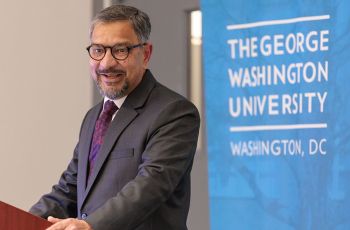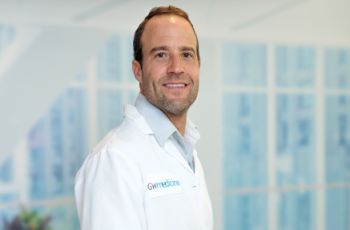
For Anelia Horvath, the big picture comprises tiny particles. She studies genetic variants from single-cell RNA-sequencing data, and these little pieces of the puzzle are leading to important discoveries and answering huge questions.
What’s your story?
I came to the United States from Bulgaria with my two young children in 2004. We planned to live here for two or three years to take advantage of learning opportunities and then return — we were quite happy living in Bulgaria! But as time passed, I realized that with how quickly science moves and how difficult it is to relocate children from one country to another, so we decided to stay.
I had a postdoctoral position at NIH and then became the Executive Director of Molecular Genomics, and my interest in bioinformatics developed. A big part of that interest came from being at one of the first labs at NIH that launched next-generation sequencing research. It was very exploratory, very pioneering, and very exciting. And, to be honest, it was a little scary because we weren’t sure if we were doing things correctly, and there were so few people we could discuss these ideas with. Over the ten years I was at NIH, I learned a lot about how genome sequencing works, and it became my passion.
Since 2013, I’ve been the Director of the McCormick Genomic and Proteomic Center (MGPC), among other roles, here at GW. It’s exciting to see more and more scientists using genome sequencing approaches, which is because of the work we’re doing at MGPC.
Another exciting component of my work is delving progressively deeper into smaller biological components —moving from organisms to cells and ultimately to the molecular level. It’s absolutely fascinating.
What gets you out of bed in the morning?
On a practical note, it’s my dog, Nash. He wakes me up, and we go for an early morning walk. But there’s so much more to it than that. I really love my life. And that makes it very exciting to get out of bed each morning.
I have two amazing daughters, who are now grown. I love my entire family. Spending time with all of them, either in person or on the phone, is very enjoyable. My job is exciting. I come to the [Horvath] lab; I work on fascinating projects with an incredible team, which keeps me engaged every moment — a truly significant thing. I also have a lot of friends with whom I enjoy spending time, exploring new places, and having fun. All of this makes me genuinely excited for each new day. Mornings are amazing.
What is that one book that has influenced you the most?
I get asked this question a lot because I am such an avid reader. I don’t have a single favorite book because so many have touched me in profound ways. It feels unfair to favor one over the others when each has left a unique and lasting impact on me. I like almost any kind of literature and poetry. I enjoy classics like Dostoyevsky's Crime and Punishment as well as South American magical realism, particularly the works of Jorge Borges and Julio Cortázar. I'm also fond of Lewis Carroll and often revisit children's books like Phone Stories and The Grammar of Fantasy by Gianni Rodari. I have a deep appreciation for Bulgarian literature and recently found Time Shelter by Georgi Gospodinov to be quite intriguing.
What absolutely excites you in cancer research right now?
I’m fortunate not to have had cancer in my family, and for that, I’m very thankful. I remember the first time I heard about cancer when I was just four or five years old. My grandfather, who was a physician, and my grandmother were talking very quietly about someone who was recently diagnosed with cancer and wasn’t expected to live for more than another month. Being that young and living in a very protective family and society, I did not hear about these types of life events. So I went to them, and I asked questions about this disease that could take you in just a month. In time, they felt obliged to answer my questions, but they tried to make it as hopeful and positive as possible.
For me, it was so painful, so horrible that someone could be diagnosed with this disease, and nothing could be done. When I got older, I started reading about cancer, and I wondered: what is this energy that actually develops and grows and kills the host while at the same time killing itself? How is this sustainable? How does it work? And then the fact that there was no reason or any explanation for cancer. It all made me very annoyed.
When I started studying genomics, I was able to combine my love of math with biology. I really like the sequences and how informative and smart they are. The difference between DNA and RNA fascinates me, and all of this is related to cancer. My lab studies genetic variations and mutations expressed at the single-cell level in cancer, exploring how they influence the disease and their potential for prediction or treatment. This is a cutting-edge field, with only a few labs worldwide engaged in this work. The novelty and exploratory nature of this research keep me both curious and excited.
What is the most interesting thing we should know about you?
When I was a child, I dreamed of becoming an astronaut. My middle school was named after Yuri Gagarin, and it had a special tradition: many astronauts, including Yuri Gagarin himself, Valentina Tereshkova (the first woman in space), and Georgi Ivanov, the first Bulgarian astronaut, would visit our school and plant pine trees in the front yard. We had tens of trees planted by astronauts, for which we, as students, were responsible for taking care. We watched them grow over the years. Although the school eventually changed its name and the pine-planting tradition ended, the pine trees continue to thrive as of summer 2024. Now, years later, as space travel becomes increasingly accessible, I am fully committed to pursuing my childhood dream of venturing beyond Earth.



